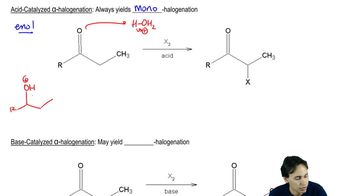Predict the products of the following hydration reactions.
b. 2-phenylpropene + dilute acid
c. 1-phenylcyclohexene + dilute acid
 Verified step by step guidance
Verified step by step guidance Verified video answer for a similar problem:
Verified video answer for a similar problem:



 6:32m
6:32mMaster General properties of acid-catalyzed hydration. with a bite sized video explanation from Johnny
Start learning